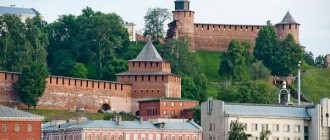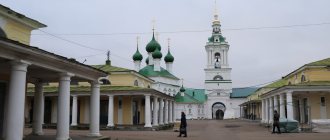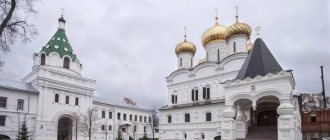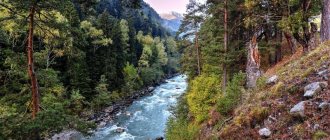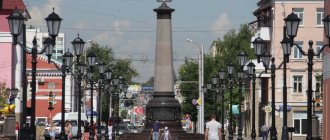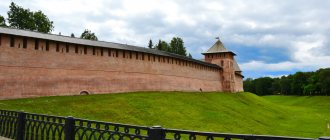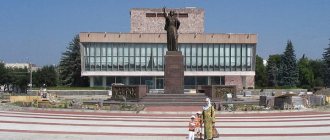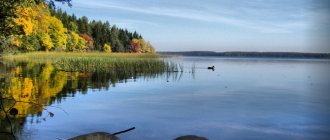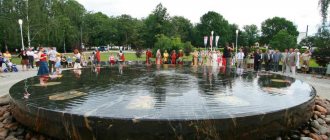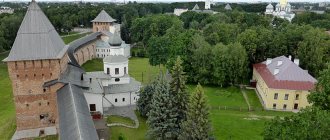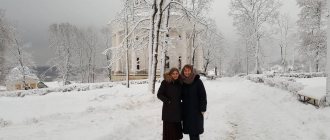Novgorod child
It was first mentioned in chronicles in 1044. The ancient mighty fortress is an architectural monument under the protection of UNESCO. The area of the modern Kremlin is 12 hectares, the length of the walls is 1.5 km, the height of the towers is 41 meters. Climbing the fortress walls and visiting the 9 towers is only possible in good weather. Interesting objects to see are the ancient cathedral and churches, the Clock Bell, the Chamber of Facets, and the sculpture “Millennium of Russia”.
Yaroslavovo Dvorishche and Torg
An extensive historical and architectural complex founded in the 10th-11th centuries. This place has preserved the spirit and atmosphere of the ancient city. Torg was the economic center of Nizhny Novgorod - long shopping arcades stretched along it. The old commercial buildings now house cafes and small shops. Yaroslav's Court is especially interesting because of its large number of ancient churches from the 12th to 18th centuries.
"Vitoslavlitsy"
The Museum of Ancient Wooden Folk Architecture, located a few kilometers from the city near Lake Myachino. The name of the museum is given by the name of the village on this site in the 12th-18th centuries. The open-air museum includes ancient buildings of the 13th-19th centuries - peasant huts, a chapel, churches, temples, a mill. They were brought here from all over the Novgorod region. Folk celebrations and folklore festivals are held on the territory of the museum.
Saint Sophia Cathedral
Founded in the 11th century and is one of the symbols of Veliky Novgorod. The majestic religious stone building has five domes that look like heroic helmets. Four domes are the color of steel, the fifth is the color of gold. The decoration of the temple is the bronze Magdeburg Gate with high reliefs and beautiful sculptures. Another valuable relic is the Vasilievsky Gate with images of biblical scenes and the ancient hero Kitovras.
Kremlin Park
It occupies an area of 25 hectares. The park is framed on three sides by the walls of the detinets. The park has many opportunities for active leisure - a go-cart track, boat rentals, a field for playing go-karts and a tennis court. From the pedestrian alley you can enjoy beautiful views of the ancient fortress or appreciate the beauty of the jets of the Sadko fountain. The park has several monuments and memorials, a stage for concerts and attractions.
Monument "Millennium of Russia"
Installed on Kremlin Square in 1862 as part of the celebration of the 1000th anniversary of Russian statehood. The composition is based on the “Monomakh’s cap,” which consists of a ball-shaped orb mounted on a bell-shaped pedestal. The height of the monument is 15.7 meters, weight – more than 100 tons. On its tiers there are 128 figures - grand dukes, statesmen, artists and writers, war heroes.
Pedestrian bridge over the Volkhov River
Located in the Yaroslav Dvorishcha area. The first city bridge was first mentioned at the beginning of the 12th century. It was rebuilt several times and functioned until 1944, when it was blown up by German troops. The bridge was restored only in 1987 according to a unique project by engineers from the Leningrad Institute. The pedestrian bridge has an interesting curved shape with arched outlines. It connects two historic city districts.
Rurik settlement
Archeological monument of the 9th century near Lake Ilmen. According to ancient chronicles, several centuries ago, a princely residence was located here. According to legends, this particular place was the capital of the state of Rurik after the Varangians called him to the kingdom. During excavations at this site, a large number of objects from Scandinavian times were found, as well as settlements from the Iron Age. The ruins of the Church of the Annunciation have been preserved at the site.
Lake Ilmen
A large lake into which about 50 rivers flow, but only one flows out - Volkhov, connecting Ilmen with Lake Ladoga. Previously, trade routes passed through the lake; currently it is used as a place for outdoor recreation. On its shore there is a natural monument - the Ilmensky Klint. There are a lot of berries and mushrooms in the forests surrounding the lake. Recreation centers have been built where guests are offered various types of active leisure.
City of Veliky Novgorod (Russia)
Veliky Novgorod is one of the oldest cities in Russia, located in the north-west of the country on the Volkhov River. This is the center of the birth of Russian statehood and the capital of one of the first European democracies. Veliky Novgorod is one of the most beautiful and interesting cities in Russia, which has preserved unique ancient Russian monuments included in the list of UNESCO World Heritage Sites.
Novgorod was first mentioned in chronicles in the 9th century. Along with Kiev, it was one of the centers of Rus' and the place where the legendary Rurik was summoned. Throughout most of the Middle Ages, Novgorod flourished through trade and was one of the richest Russian cities. Unique ancient Russian churches and a mighty Kremlin called Detinets have been preserved here to this day.
Anthony's Monastery
Anthony's Monastery retained its integrity even during the times of unbelief that reigned with the establishment of communist power, although it did not function for its intended purpose. The monastery was founded by Anthony the Roman, who arrived in the Novgorod lands from Italy. Being deeply immersed in the Orthodox faith, in 1106 he initiated the construction of a complex, which later included not only existing parishes, but also educational institutions and seminaries. The dominant feature is the Church of the Nativity of the Virgin Mary. Now it is a museum, the main decoration of which is considered to be unique frescoes created outside the models accepted in antiquity.
Guides: Russia
Moscow
Saint Petersburg
May be interesting: Other cities in Russia
Paraskeva Pyatnitsa Church at Torg
The church is not active; there is an architecture museum within its walls. During the heyday of the independence of the Novgorod principality, the main parishioners of the church were merchants who visited here in the intervals between active trade: the church was part of the corresponding space. It was the merchant people who named the church after the saint who gave patronage to representatives of this stratum of the population. The architectural solution is noticeably different from the style of the Novgorod builders, which gives reason to assume that the creators of the monument were invited from neighboring lands. Now the inside is in ruins, but the frame has been preserved - the foundation and thick walls made of limestone and brick.
Geography and climate
Veliky Novgorod is located in the north-west of the European part of Russia, 150 km from St. Petersburg and 550 km from Moscow. The city was built on the Priilmenskaya lowland on the Volkhov River, not far from its source, which is Lake Ilmen.
Novgorod has a temperate continental climate, which is characterized by relatively cold, often snowy winters and cool, rainy summers. Autumn is also quite rainy here. Winter in Novgorod usually lasts from November to March.
Churches of Veliky Novgorod
Rurik's Settlement
When Rurik and his brothers came to Novgorod land, settlements already existed here, which suggests that the founding date is approximately the 8th century. The territory on a natural hill at the source of the Volkhov was considered the Old City. When active development began on the left bank, the foundation of the Kremlin was laid, and the New City, later known as Novgorod, began to form. The need for “escalation” was caused by population growth. Currently, the ruins of the Church of the Annunciation can be seen in the perimeter. The building was destroyed by bomb explosions of the German invaders.
Story
Novgorod was first mentioned in chronicles in 859. Although scientists believe that the Slavic settlement on the Volkhov River was founded in the 7-8 centuries. The oldest part of the city is the Rurik settlement, located 2 km from the modern center and which later became a princely residence. Novgorod (“New City”) was founded in the 10th century and became one of the centers of Rus', as well as the capital of the republic of the same name, which existed until the 15th century, until it was subjugated by Moscow.
The exact date of the founding of Veliky Novgorod is still controversial. Many are sure that the settlement here was founded by the Ilmen Slovenes and existed even before the arrival of Rurik.
Novgorod has a rich and ancient history. The Independent Novgorod Republic was founded in 1136 and is considered one of the oldest European democracies. It flourished due to its favorable geographical position and intensive trade. The Volkhov River historically divides the city into two parts: Trade and Sofia, which in the Middle Ages competed with each other, which often escalated into serious conflicts.
Detinets Towers
In 862 (according to ancient chronicles), Rurik was invited to reign. In 864, the Novgorodians rebelled against the Varangians, but it was suppressed. In the 11th century the city was captured and plundered by the Polotsk princes. By the 12th century, Novgorod had conquered vast lands from southern Finland and Karelia to the Urals.
In the first half of the 12th century, the Novgorod Republic was founded. The 13th century is one of the most difficult in the history of the city. In 1212 there was a terrible fire, and in 1230 there was an equally terrible famine. Although in 1238 the city was lucky - the Tatar-Mongols did not reach the city only 200 km. In 1240, the Novgorodians, led by Prince Alexander, defeated the Swedes in the Battle of the Neva. In 1242, Alexander, nicknamed Nevsky, defeated the Teutonic knights on Lake Peipsi. This battle is better known as the Battle of the Ice.
Pedestrian bridge over Volkhov
In the second half of the 13th century, Novgorod entered into an agreement with several cities of the Hanseatic League. In 1478, the city was subjugated by the Moscow princes, which marked the end of the Novgorod Republic. After this, Veliky Novgorod gradually loses its importance. Under Ivan the Terrible, the guardsmen ravaged the city and killed many residents. At the beginning of the 17th century, Novgorod was occupied and devastated by the Swedes.
In 1708, the city was included in the St. Petersburg province. In 1727, the Novgorod province was founded. In 1927, the province became part of the Leningrad region. During the Great Patriotic War, Novgorod was occupied by the Nazis from August 1941 to January 1944. The war left a terrible mark, destroying many ancient monuments. In 1999 the city was renamed Veliky Novgorod
Excursions
Exploring Veliky Novgorod on your own in 2 days is not difficult. But to learn in detail the history of the city from its founding to the present day, it is worth taking a guided tour. Veliky Novgorod guides offer both introductory walks around the main tourist sites and more in-depth excursions on a specific topic: following the events of the Great Patriotic War or the ancient monasteries of the city. The guide will not only tell you the history of Veliky Novgorod, but will also give valuable recommendations for leisure activities in the city.
Photo: © Sergey Arkhipkin
Attractions
To this day, Veliky Novgorod has preserved several magnificent monuments of ancient Russian architecture, which are included in the list of UNESCO World Heritage Sites.
Novgorod Kremlin
Kremlin or Detinets
The main attraction of the city is the impressive Kremlin or Detinets. It was founded by Yaroslavl the Wise and was first mentioned in 1044, being the oldest building of its type in Russia. The Kremlin was the administrative and religious center of the ancient city, where veches and other important historical events took place.
The Novgorod Kremlin looks most impressive from the Volkhov side. An ancient road passes through it, connecting the Sofia and Trade parts of Novgorod.
Detinets is considered one of the most significant ancient Russian fortresses and a unique monument of medieval architecture. The Novgorod Kremlin has a total area of about 12 hectares and the length of the walls is 1.5 km. The walls of Detinets range in height from 8 to 15 meters and thickness from 3 to 6 meters. The Kremlin is surrounded by a deep moat. Of the twelve original towers, nine have survived: Dvortsovaya, Spasskaya, Knyazhaya, Kokuy, Pokrovskaya, Zlatoustovskaya, Metropolitan, Fedorovskaya and Vladimirskaya.
The tallest tower of the Novgorod Kremlin is Kokuy. This is a 17th century watchtower with a height of almost 39 meters, which is different from the other towers of Detinets.
Saint Sophie Cathedral
Sights of the Kremlin
Hagia Sophia is the oldest (surviving) ancient Russian temple and a symbol of Novgorod for almost a thousand years. The temple was built in the first half of the 11th century by Yaroslav the Wise and his son Prince Vladimir. St. Sophia Cathedral has always been important for Novgorodians, who said: “Where St. Sophia is, there is Mr. Veliky Novgorod.”
St. Sophia Cathedral was built by Kyiv and Byzantine architects in the traditional Russian style. Stone, limestone, shell rock and brick were used in construction. The building has five domes. The central one is gilded. The main entrance to the church is the western one. The 12th century Magdeburg Gate, a war trophy from Sweden, is located here.
The cathedral has preserved fragments of ancient frescoes from the 11th-12th centuries, as well as later paintings from the 19th century. Unfortunately, the original iconostasis from the 12th century has not survived. The existing iconostasis dates from the 14th to 16th centuries and contains several valuable relics. A little away from the cathedral there is a belfry, mentioned since the 15th century.
Monument to the Millennium of Russia
The Monument to the Millennium of Russia was erected in Novgorod by order of Emperor Alexander II in 1862 to commemorate the thousand-year history of the state. The history of the Russian state begins with the calling of Rurik to reign. The monument is made of bronze and contains 129 figures representing the history of Russia from the 9th to the 19th centuries. Unfortunately, the original monument was damaged by the Germans during the Great Patriotic War, but was restored in 1944.
At the ticket office of the Sofia Belfry you can buy tickets that allow you to take a walk along the “combat passage” of the Kremlin (along the walls of Detinets with a visit to some towers).
Other attractions of the Novgorod Kremlin:
- The Church of St. Andrew Stratelates is a small ancient church in the southern part of the Kremlin. Originally it was a chapel (annex) of the Church of Boris and Gleb, founded in the 12th century. In the 17th century, this temple collapsed, and its chapel became an independent church.
- The Faceted Chamber is the only surviving building of the Vladychny Court (an administrative complex in the northwestern part of the Kremlin). The chamber is a three-story brick building, built in the first half of the 15th century in a unique (for Rus') Western Gothic style. There are several interesting exhibitions inside.
- The Public Offices building was built in the 18th century in the classicist style and was the administrative center of the Novgorod province. Now the main building of the museum is located within its walls.
Historical and architectural monuments
Yaroslavovo Dvorishche
Yaroslavovo Dvorishche is the site of an ancient trade (market) near the Volkhov River, one of the busiest places in medieval Novgorod and one of the foundations of its prosperity. The market on this site was formed in the 11th-12th centuries and was one of the largest at that time in Europe. In addition to Russian merchants, Hanseatic traders also made profitable deals here.
In the Middle Ages, along the market there were piers where numerous ships were moored. Now you can see several interesting buildings here: from a 12th century temple to civil buildings of the 17th century. The long arcade, which is a modern symbol of bargaining, was built during the time of Peter the Great for the Gostiny Dvor.
Alekseevskaya Tower
The Alekseevskaya Tower is the only surviving part of the defensive fortifications of the Okolny City (the outer walls of Novgorod). The tower was built at the end of the 16th century. Located in the southern part of the Sofia side.
An interesting object is the Hanseatic Fountain, built in 2009. It is made of granite and bears the coats of arms of the Hanseatic cities.
Rurik's settlement
Rurik's settlement is the oldest part of Novgorod, a fortified settlement of the Viking Age, where the princely residence of Rurik was located. The settlement was founded in the 9th century and is actually an “old city” in relation to modern Novgorod, which was founded in the 10th century. The princely residence here existed until the reign of Ivan the Terrible.
Unfortunately, the Rurik settlement is now in ruins. Here you can see fragments of outbuildings, as well as the walls of the Annunciation Cathedral, founded by Mstislav the Great at the beginning of the 12th century.
Churches and monasteries of Veliky Novgorod
Znamensky Cathedral
Znamensky Cathedral is a 17th-century church built by Moscow craftsmen in the traditional Central Russian style on the site of an older 14th-century church. Known for its unusual frescoes.
Monastery of the Tithe of the Nativity of the Virgin Mary
According to legend, the Tithe Monastery of the Nativity of the Virgin was founded at the end of the 10th century. Although most likely the monastery was founded in the 13-14th century. In any case, written mentions of it date back to this period. Its highlight is the tall 19th-century stone bell tower, which was rebuilt in 1903. Unfortunately, the monastery church was damaged during the Great Patriotic War and was dismantled for building materials in the 60s of the 20th century.
Church of the Assumption of the Virgin Mary on Volotovo Field
The Church of the Assumption of the Virgin Mary on Volotovo Field is a small ancient church in the traditional Russian style, located in the suburbs of Novgorod (not far from the M10 motorway). The church was famous for its unique frescoes. Once upon a time, its walls were decorated with several hundred artistic compositions. The building was destroyed during the Great Patriotic War, and the wonderful frescoes were seriously damaged.
Anthony's Monastery
Anthony's Monastery was founded in the first half of the 12th century. According to legend, it was founded by Anthony, who was born in Rome. In 1117, the Cathedral of the Nativity of Christ, famous for its beautiful paintings and frescoes, was founded. The monastery was destroyed by the guardsmen in the 16th century and by the Swedes at the beginning of the 17th century.
St. George's Monastery
St. George's Monastery is the oldest Orthodox monastery in Veliky Novgorod, mentioned since the 12th century. Located at the source of the Volkhov River on the southern borders of the city. According to legend, the St. George's Monastery was founded in 1030 by Yaroslav the Wise. Although the first written mentions of it date back to 1119.
The monastery complex includes the magnificent ancient main church of St. George with fragments of frescoes, a 52-meter bell tower, several churches and utility buildings. The monastery is still active, and the church of St. George was used as a tomb for the Novgorod princes.
Holy Spirit Monastery
The Holy Spirit Monastery has been mentioned in chronicles since the 12th century. In the Middle Ages it was one of the largest monasteries in Novgorod. To this day, two churches have survived from the monastery (Holy Spirit and Holy Trinity). Church of St. Duha was founded in the 14th century and completely rebuilt in the 19th century. Church of St. Trinity Church dates from the 16th century and is considered a prime example of Russian religious architecture from that period.
Zverin Monastery
The Zverin Monastery was founded in 1148 on the site of the princely hunting grounds. Its architectural dominant is the Intercession Cathedral, built at the beginning of the 20th century, as well as several small medieval churches.
Church of St. Sergius of Radonezh
The Church of St. Sergius of Radonezh was built in the 15th century in the last years of the Novgorod Republic on the territory of Detinets. What stands out in its architecture is the Chasozvonya, a high 40-meter tower.
Paraskeva Pyatnitsa Church
The Church of Paraskeva Pyatnitsa was built at the beginning of the 13th century by foreign merchants and is located on an ancient market. Dedicated to the patron of merchants.
St. Nicholas Cathedral
St. Nicholas Cathedral is a symbol of the Trade Side and the oldest religious building in this part of Novgorod. The cathedral is the architectural dominant feature of the auction. It was founded in the first half of the 12th century and is a masterpiece of ancient Russian architecture (although motifs from Hagia Sophia and Byzantine architecture can be traced in its structure). St. Nicholas Cathedral was in a deplorable state by the 90s and was restored with the participation of the Hanseatic League of modern times.
John's Church on Opoki
The Church of John on Opoki is a medieval church at the market, built in the first half of the 12th century by Novgorod merchants. In 1453, the old church was dismantled and a new building was built on its foundation.
Church of Fyodor Stratilates on Shchirkovaya Street
The Church of Fyodor Stratilates on Shchirkovaya Street was built in the 13th century on the site of an older church. The building acquired its current appearance in the 17th century. At the beginning of the 19th century, a baroque bell tower was added to the church.
Church of the Transfiguration
The Church of the Transfiguration is a small 14th century church built by residents of Ilyina Street. It is best known for its unique frescoes by the legendary icon painter Theophanes the Greek, who painted several dozen churches, but his paintings have been preserved only here.
Church of Fyodor Stratilates on the Stream
The Church of Fyodor Stratilates on the Stream is a beautiful medieval church in the traditional Russian style. Here you can see magnificent paintings from the 14th century, which may have been painted by students of Theophanes the Greek.
Church of Peter and Paul in Kozhevniki
The Church of Peter and Paul in Kozhevniki was considered one of the most beautiful churches in Novgorod. It was built at the beginning of the 15th century in an area where fur craftsmen lived. The building has preserved the original structure of the late Novgorod Republic period.
Trinity Church on Redyatinaya Street
Trinity Church on Redyatinaya Street was founded in the 12th century. The stone church on this site was built in the 14th century. In the 18th century the building was rebuilt. In the 19th century, a bell tower was added to it.
Church of the Nativity on Red Field
The Church of the Nativity of Christ on the Red Field is a small stone church from the 14th century that has preserved its original historical appearance and frescoes from this period.
Church of the Transfiguration on Kovalevo Pole
The Church of the Transfiguration on Kovalevoye Pole was built in the 14th century by order of a Novgorod boyar. The church was famous for its beautiful frescoes. During the Great Patriotic War, the building was completely destroyed and restored in the post-war years.
Yuriev Monastery
The active monastery is popular as a landmark place on the route of pilgrims from all over the country, and as a landmark location included in tourist excursion programs. The monastery was founded by Yaroslav the Wise, according to chronicle sources. The architectural complex consists of three cathedrals (Spassky, St. George and Five-domed Holy Cross) and several small churches. From the platforms at the top of the bell towers you can enjoy a panoramic view of the picturesque surroundings, in particular the Volkhov riverbed. The color scheme is a combination of white (fortress walls) and red (tiled roofs). The interior decoration was badly damaged during the Soviet era, but in some galleries parts of wall paintings dating back to the 12th century have been preserved.
Ecology
The Volkhov River and its basin are well developed and widely used in economic activities. The Volkhov hydroelectric power station was built in the lower reaches.
Industry, municipal water supply, waste and drainage water discharge, fishing, pollution from transport, and hydropower lead to a constant deterioration in water quality.
According to laboratory studies, large amounts of iron, copper, manganese and other metals were noted in the river. This indicates the negative impact of industrial activity on the ecology of the region.
Yaroslav's yard and bargaining - back to merchant Rus'
Church of Paraskeva Pyatnitsa on Torg / photo by S. Makhlov
Prince Yaroslav lived on the trading side - this is described in the chronicle.
Afterwards, merchants occupied the land, expanding trade here. Overseas ships approached the pier. In the 16th century, about 2,000 shops and barns were located on a small plot of land at Torg.
In the 18th century, Gostiny Dvor was built on this site. The Gate Tower (XVII century) and the Arcade (XVIII century) are the only things left from it.
Behind the Arcade, 7 temples were “clustered together”, which were erected by princes and merchants.
The churches at Torgu are a miracle of northern temple architecture. Worth a look:
- St. Nicholas Cathedral of 1136 is the oldest. Fragments of original painting from the 12th century have been preserved in the interior.
- The Church of Paraskeva Pyatnitsa is a cross-domed, three-nave, four-pillar building built in 1207. Novgorod merchants considered Saint Paraskeva their patroness. Now they are praying for her female destiny - they go around her 3 times, counting the corners.
- The Church of the Myrrh-Bearing Women, 1510, is austere, almost without decoration, made of bricks of different sizes. Take a look at the under-church and immerse yourself in the past - there are exhibitions about carpentry, leatherwork, shoemaking, and fishing, interactive excursions and master classes are held here.
How to get there
Right bank of the Volkhov River, address: st. Bolshaya Moskovskaya, 1.
Use an audio guide for a walk along the Trade Side.
Industrial enterprises
Enterprises of the regional center have demonstrated positive dynamics for a number of years. More than 60 percent of the region's entire industry is concentrated here. According to its structure, the enterprise belongs to:
- Processing industry
- Energy production
- Chemical industry
- Food industry
- Mining
- Electronic equipment manufacturing
- Woodworking
The largest enterprise is the Acron mineral fertilizer plant, part of the holding of the same name. Known since Soviet times as a leader in the chemical industry. Fertilizer production accounts for about 40 percent of the city's gross product. The enterprise occupies an area of 600 hectares and employs about 2 thousand people. The average salary exceeds the city indicator - more than 35 thousand rubles. Excellent conditions for work and recreation, sports, and treatment of workers have been created here.
The company has its own sports center with a swimming pool and playgrounds. There is the Akron Palace of Culture, where interesting events take place. If you manage to get a job at a factory, consider yourself and your household very lucky.
The Victory Monument is the only equestrian statue in Novgorod
Victory Monument / photo S. Makhlov
The monument was erected in the year of the 30th anniversary of the liberation of Novgorod from the Nazis.
An interesting detail is that under the horse’s belly there is a mangled swastika. Behind the statue is a 23.5 m high brick tower. It is not possible to climb to the observation deck - the entrance is closed due to emergency conditions.
At the foot there is a small exhibition of military equipment: a T-70 light tank and 76 mm guns.
How to get there
The monument is located in the southern part of the Kremlin Park on Catherine Hill. It can be seen from the Settlement and from the bridge.
Hanseatic fountain - water “negotiation table”
Fountain with flags of the countries of the Hanseatic League / photo by S. Makhlov
Hansa is a powerful trade union of 130 cities that arose in the 13th century. Of the Russian cities, only Novgorod and Pskov were included in it.
In the 80s of the 20th century, the Union was recreated, and in 2009 a special sign and fountain were installed in Veliky Novgorod.
The black granite fountain is stylized as a negotiation table. It depicts the coats of arms of 16 countries of the Hanseatic League in modern times. On sunny days, the images seem to glow from under the water. Countries are not signed, test your knowledge of coats of arms.
How to get there
You will find the fountain on the territory of Yaroslav's courtyard.

